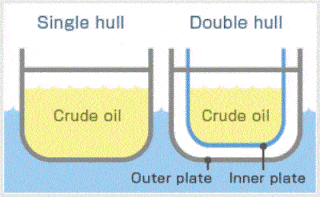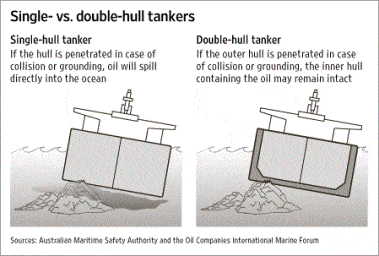Single Hull Vs Double Hull Tankers
Double hull, as the name suggests, are tanker ship hulls with double layers of watertight hull surface. The inner and outer layers of the hull are on the bottom as well as the sides of the tanker ships. The double layer construction helps in reducing the risks of marine pollution during collision, grounding, and any other form of ship’s hull damage.

Single hull have only one outer watertight layer which runs throughout the structure of the tanker ship. As a result of only one layer, single hull tankers pose a greater threat to marine environment during any kind of accidents.
The International Maritime Organisation (IMO) introduced the regulation 13 F of Annex 1 of MARPOL, which effectively mandated double hulls for new built oil tankers of 5000 dead weight tonnage and above. The Exxon Valdez oil spill disaster also led U.S. Government to make double hulls compulsory for all new tanker ships coming to the U.S. ports. After the sinking of Erika off the coast of France in December 1999, IMO proposed accelerating phase out of single hull ships. Single Hull Tankers Phase-out time table can be found here.
Difference between Single Hull and Double Hull Tankers
In double hull tankers, the space between the two layers is used as dedicated ballast tanks for ensuring ship’s stability.
The ballast spaces extend for the full length of the cargo carrying area, providing an extensive safety measure. Single hull tankers do not have such ballast spaces.

In comparison to single hull design, double hull design is said to have less stability as it raises the centre of gravity and reduces the meta-centric height of the ship. Moreover, there is a risk of loss of stability because of free surface effects in cargo and ballast tanks. Single hull ships are considered more stable as compared to double hull tankers.
Corrosion is considered one of the main reasons for failure of hull structures in tankers. Improper maintenance of ballast tank structures and failure to maintain the integrity of protective coating andcathodic protection in ballast tanks have lead to structural failure in the past. In double hull tankers, the surface area of the tanks is more than double than that of single hull tanks. Thus they require more maintenance during the operating life.
As compared to the ballast tanks of single hull ships, those of the double bottom tanks are easily accessible because of their increased height and width. This makes the work during inspection much easier. However proper precautions must be takeninto consideration while entering confined spaces of ballast tanks.

Structures of ballast spaces in double hull tankers are more susceptible to hull fractures and minor failures as compared to single hull tankers. Double hull tanker operators have often complained about cargo leakage into ballast tanks as a result of stress concentration, fatigue, or construction defects.
Tanker ships with single hull design often faced problems of leakage of ballast water into cargo from ballast water pipes passing through cargo tanks. This problem also increased the risks of pollution during ballasting and de-ballasting from single hull tankers as leaking pipes passing through cargo tanks can contaminate the clean ballast water. The double hull design removed this problem with different piping systems passing through only the respective tanks.
The surface area of ballast tanks is higher in double hull ships as compared to that of single hull. This is because of longer and narrower double bottom tanks which increases the surface area two to three times as compared to single hull tanks. However the design of the double hull ships makes the access to the confined spaces of the tanks more difficult as compared to the spacious ballast tanks of single hull ships.
According to a research, stresses in the structure of double hull ships are much higher than that in single hull ships.
Thus double hull ships are more susceptible to minor structural failures as compared to the single hull tankers. This can also be a matter of concern during accidents which cause oil spill as a result of structural failure.
Ventilation is of utmost importance in double bottom tanks of double hull tankers as they need inspection from time to time. As double bottom tanks are free from any internal structure, it is easy to access them. However, they are not so friendly when it comes to close-up inspection, or accessing side tanks or deck head areas; whereas though tanks of single hull are difficulty to access, their confined areas much more ‘inspection friendly.’
Source: http://www.marineinsight.com/
Leave a reply
